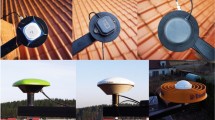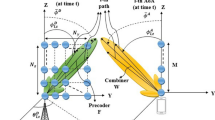Abstract
In this paper, we develop a novel three-dimensional (3D) multiantenna array for enhancing the performance of multiple input multiple output systems. This array is composed of two uniform circular arrays (UCAs). A frequency nonselective Rayleigh fading channel model is introduced to calculate the spatial fading correlation (SFC) and capacity of a multipath channel. Then, the influence of the rotation angle \(\phi _0\) and the perpendicular distance h of the upper UCA in a double uniform circular array (DUCA) with reference to the lower UCA and the radius r of the DUCA on the SFC and the capacity are investigated. In addition, the DUCA is applied to a multiple signal classification algorithm in order to estimate the direction of arrival (DOA). Simulation results show that \(\phi _0\) which results in the minimum correlation and the maximum capacity depends on the angle of arrival, and the increase in h and r enhances the capacity performance. However, when \(h/\lambda >1/2, h\) has little effect on the capacity. Comparing the spatial spectrum and the root mean square error of the DUCA with a general uniform linear array, UCA, and 2-L array, this paper shows that 3D antenna arrays have significant advantages in DOA estimation.









Similar content being viewed by others
References
Damnjanovic, A., Montojo, J., Wei, Y., Ji, T., Luo, T., Vajapeyam, M., et al. (2011). A survey on 3GPP heterogeneous networks. IEEE Wireless Communications, 18(3), 10–21.
Adachi, F., & Ohno, K. (1991). BER performance of QDPSK with postdetection diversity reception in mobile radio channels. IEEE Transactions on Vehicular Technology, 40(1), 237–249.
Buyukcorak, S., & Karabulut, K. G. (2011). Simulation and measurement of spatial correlation in MIMO systems with ray tracing. IEEE 5th International Conference on Signal Processing and Communication Systems, Honolulu, Hawaii, pp.1–5.
Petrus, P., Reed, J. H., & Rappaport, T. S. (2002). Geometrical-based statistical macrocell channel model for mobile environments. IEEE Transactions on Communications, 50(3), 495–502.
Zhou, J., Qiu, L., Li, C., & Kikuchi, H. (2012). Analyses and comparisons of geometrical-based channel model arisen from scatterers on a hollow-disc for outdoor and indoor wireless environments. IET Communications, 6(17), 2775–2786.
Kyritsi, P., Cox, D. C., Valenzuela, R. A., & Wolniansky, P. (2002). Effect of antenna polarization on the capacity of a multiple element system in an indoor environment. IEEE Journal on Selected Areas in Communications, 20(6), 1227–1239.
Shin, H., & Lee, J. H. (2003). Capacity of multiple-antenna fading channels: Spatial fading correlation, double scattering, and keyhole. IEEE Transactions on Information Theory, 49(10), 2636–2647.
Zhou, J., Sasaki, S., Muramatsu, S., Kikuchi, H., & Onozato, Y. (2003). Spatial correlation for a circular antenna array and its applications in wireless communication. IEEE Global Telecommunications Conference, San Francisco, CA, 2, 1108–1113.
Wang, H., Wang, L., & Li, H. (2009). A novel numerical model for simulating three dimensional MIMO channels with complex antenna arrays. IEEE Transaction on Antenna and Propagation, 57(8), 2439–2450.
Yong, S. K., & Thompson, J. S. (2005). Three-dimensional spatial fading correlation models for compact MIMO receivers. IEEE Transactions on Wireless Communications, 4(6), 2856–2869.
Jiang, H., Zhou, J., & Kikuchi, H. (2015). Performance of uniform concentric circular arrays in a three-dimensional spatial fading channel model. Wireless Personal Communications, 83(4), 2949–2963.
Zhou, J., Qiu, L., & Kikuchi, H. (2013). Analysis of MIMO antenna array based on electromagnetic vector sensor. (China). Journal on Communications, 34(5), 1–11.
Hajian, M., Coman, C., & Ligthart, L. P. (2006). Comparison of circular, Uniform-and non Uniform Y-Shaped Array Antenna for DOA Estimation using Music Algorithm. The 9th European Conference on Wireless Technology, Manchester, England, pp.143–146
Tayem, N., & Kwon, H. M. (2005). L-shape 2-dimensional arrival angle estimation with propagator method. IEEE transactions on antennas and propagation, 53(5), 1622–1630.
Schmidt, R. O. (1981). A signal subspace approach to multiple estimator location and spectral estimation. Stanford, CA: Stanford University. Ph.D. dissertation.
Schmidt, R. O. (1979). Multiple emitter location and signal parameter estimation. Rome, Italy: Proc. RADC Spectrum Estimation Workshop. C258.
Roy, R. H. (1987). ESPRIT-estimation of signal parameters via rotational invariance techniques. Stanford: Stanford University. Ph.D. dissertation.
Roy, R., & Kailath, T. (1990). ESPRIT-Estimation of signal parameters via rotational invariance techniques. Optical Engineering, 29(4), 296. C313.
Yong, S. K., & Thompson, J. S. (2003). A 3-dimensional spatial fading correlation model for electromagnetic vector sensors. IEEE Antennas wireless Propagation Letter, 2(1), 843–846.
Baysal, U., & Moses, R. L. (2003). On the geometry of isotropic arrays. IEEE Transaction on Signal Processing, 51(6), 1469–1478.
Harabi, F., Gharsallah, A., & Marcos, S. (2009). Three-dimensional antennas array for the estimation of direction of arrival. IET on Microwave, Antenna and Propagation, 3(5), 843–849.
Goldsmith, A. (2005). Wireless Communications. England: Cambridge University Press.
Andersen, J. B., & Pedersen, K. I. (2002). Angle-of-arrival statistics for low resolusion antenna. IEEE Transaction on Antennas Propagation, 50(3), 391–395.
Pollock, T. S., Abhayapala, T. D., & Kennedy, R. A. (2003). Introducing space into space-time MIMO capacity calculations: A new closed form upper bound. Proceedings of the IEEE International Conference on Telecommunications, 24(2–4), 1536–1541.
Buehrer, R. M. (2002). The impact of angular energy distribution on spatial correlation. Proceedings of the IEEE 56th Vehicular Technology Conference, 2, 1173–1177. Fall.
Gradshteyn, I. S., & Ryzhik, I. M. (1999). Table of integrals, series and products (7th ed.). San Diego, CA: Academic.
Acknowledgments
The authors would like to thank the reviewers for their constructive comments, which greatly helped improve this paper. They also acknowledge Professor Fumiyuki Adachi for his help in completing this paper, Department of Electrical and Electronic Engineering, Tohoku University, Japan. This research was supported by the National Natural Science Foundation of China(No. 61372128 and 61471153) and the Major Program of the Natural Science Foundation of Institution of Higher Education of Jiangsu Province (No.14KJA510001).
Author information
Authors and Affiliations
Corresponding author
Appendix A
Appendix A
where \(G_1=1/(4\Delta _\varphi \sin \theta _0\sin \Delta _\theta )\); \(\beta =\varphi +\xi\); \(Z_1=\frac{2\pi r}{\lambda }(\cos \alpha _m-\cos \alpha _n), Z_2=\frac{2\pi r}{\lambda }(\sin \alpha _m-\sin \alpha _n)\), and \(Z_3=-\frac{2\pi h}{\lambda }\) with \(Z=\sqrt{Z_1^2+Z_2^2}\), and \(\xi =\tan ^{-1}(Z_1/Z_2)\). The real and imaginary part of \(\rho (m,n)\) can be derived as
In these formulas, \(\cos (Z\sin \beta \sin \theta ), \cos (Z_3\cos \theta ), \sin (Z\sin \beta \sin \theta )\), and \(\sin (Z_3\cos \theta )\) can be expressed by the modified Bessel functions as follows [26]
where \(J_k\) is the Bessel function of the kth order. Substitute finite series as follows for the Bessel functions
Substituting (29)–(33) for (27) and (28) and using (18) and (19), the closed-form expression of SFC between \(a_m\) and \(b_n\) can be derived.
Rights and permissions
About this article
Cite this article
Wang, Y., Zhou, J. & Kikuchi, H. Performance of a Three-Dimensional Antenna Array and Its Application in DOA Estimation. Wireless Pers Commun 89, 521–537 (2016). https://doi.org/10.1007/s11277-016-3285-x
Published:
Issue Date:
DOI: https://doi.org/10.1007/s11277-016-3285-x




